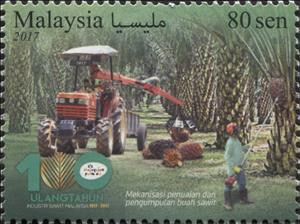Stamp: Harvesting and collecting (Malaysia 2017)
Harvesting and collecting (Malaysia 2017)
18 May (Malaysia ) within release 100th Anniversary of Oil Palm Industry goes into circulation Stamp Harvesting and collecting face value 80 Malaysian sen
| Stamp Harvesting and collecting in catalogues | |
|---|---|
| Michel: | Mi: MY 2338 |
| WADP Numbering System - WNS: | WAD: MY 032.17 |
Stamp is horizontal format.
Malaysia celebrates 100th year anniversary of the oil palm industry.Also in the issue 100th Anniversary of Oil Palm Industry:
- Souvenir Sheet - Palm fruit cluster face value 3;
- Souvenir Sheet - Palm fruit cluster face value 3;
- Stamp - Various palm oil products face value 60;
- Stamp - Harvesting and collecting face value 80;
- Stamp - Oil palm transportation in farm face value 1;
Stamp Harvesting and collecting it reflects the thematic directions:
Agricultural machinery is machinery used in farming or other agriculture. There are many types of such equipment, from hand tools and power tools to tractors and the countless kinds of farm implements that they tow or operate. Diverse arrays of equipment are used in both organic and nonorganic farming. Especially since the advent of mechanised agriculture, agricultural machinery is an indispensable part of how the world is fed.
Agriculture is the cultivation and breeding of animals, plants and fungi for food, fiber, biofuel, medicinal plants and other products used to sustain and enhance human life.[1] Agriculture was the key development in the rise of sedentary human civilization, whereby farming of domesticated species created food surpluses that nurtured the development of civilization. The study of agriculture is known as agricultural science. The history of agriculture dates back thousands of years, and its development has been driven and defined by greatly different climates, cultures, and technologies. Industrial agriculture based on large-scale monoculture farming has become the dominant agricultural methodology.
In microeconomics, an industry is a branch of an economy that produces a closely related set of raw materials, goods, or services.For example, one might refer to the wood industry or to the insurance industry.
The Arecaceae is a family of perennial, flowering plants in the monocot order Arecales. Their growth form can be climbers, shrubs, tree-like and stemless plants, all commonly known as palms. Those having a tree-like form are called palm trees. Currently, 181 genera with around 2,600 species are known,
most of which are restricted to tropical and subtropical climates. Most palms are distinguished by their large, compound, evergreen leaves, known as fronds, arranged at the top of an unbranched stem, except for the Hyphaene genus, who has branched palms. However, palms exhibit an enormous diversity in physical characteristics and inhabit nearly every type of habitat within their range, from rainforests to deserts.



